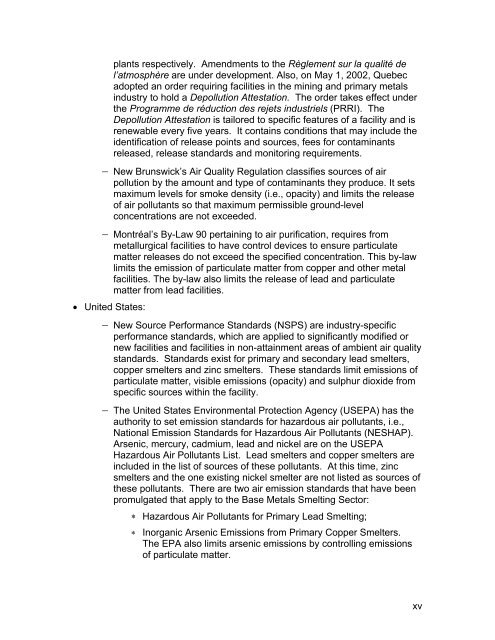(MERAF) for the Base Metals Smelting Sector - CCME
(MERAF) for the Base Metals Smelting Sector - CCME
(MERAF) for the Base Metals Smelting Sector - CCME
Create successful ePaper yourself
Turn your PDF publications into a flip-book with our unique Google optimized e-Paper software.
plants respectively. Amendments to <strong>the</strong> Règlement sur la qualité de<br />
l’atmosphère are under development. Also, on May 1, 2002, Quebec<br />
adopted an order requiring facilities in <strong>the</strong> mining and primary metals<br />
industry to hold a Depollution Attestation. The order takes effect under<br />
<strong>the</strong> Programme de réduction des rejets industriels (PRRI). The<br />
Depollution Attestation is tailored to specific features of a facility and is<br />
renewable every five years. It contains conditions that may include <strong>the</strong><br />
identification of release points and sources, fees <strong>for</strong> contaminants<br />
released, release standards and monitoring requirements.<br />
− New Brunswick’s Air Quality Regulation classifies sources of air<br />
pollution by <strong>the</strong> amount and type of contaminants <strong>the</strong>y produce. It sets<br />
maximum levels <strong>for</strong> smoke density (i.e., opacity) and limits <strong>the</strong> release<br />
of air pollutants so that maximum permissible ground-level<br />
concentrations are not exceeded.<br />
− Montréal’s By-Law 90 pertaining to air purification, requires from<br />
metallurgical facilities to have control devices to ensure particulate<br />
matter releases do not exceed <strong>the</strong> specified concentration. This by-law<br />
limits <strong>the</strong> emission of particulate matter from copper and o<strong>the</strong>r metal<br />
facilities. The by-law also limits <strong>the</strong> release of lead and particulate<br />
matter from lead facilities.<br />
• United States:<br />
− New Source Per<strong>for</strong>mance Standards (NSPS) are industry-specific<br />
per<strong>for</strong>mance standards, which are applied to significantly modified or<br />
new facilities and facilities in non-attainment areas of ambient air quality<br />
standards. Standards exist <strong>for</strong> primary and secondary lead smelters,<br />
copper smelters and zinc smelters. These standards limit emissions of<br />
particulate matter, visible emissions (opacity) and sulphur dioxide from<br />
specific sources within <strong>the</strong> facility.<br />
− The United States Environmental Protection Agency (USEPA) has <strong>the</strong><br />
authority to set emission standards <strong>for</strong> hazardous air pollutants, i.e.,<br />
National Emission Standards <strong>for</strong> Hazardous Air Pollutants (NESHAP).<br />
Arsenic, mercury, cadmium, lead and nickel are on <strong>the</strong> USEPA<br />
Hazardous Air Pollutants List. Lead smelters and copper smelters are<br />
included in <strong>the</strong> list of sources of <strong>the</strong>se pollutants. At this time, zinc<br />
smelters and <strong>the</strong> one existing nickel smelter are not listed as sources of<br />
<strong>the</strong>se pollutants. There are two air emission standards that have been<br />
promulgated that apply to <strong>the</strong> <strong>Base</strong> <strong>Metals</strong> <strong>Smelting</strong> <strong>Sector</strong>:<br />
∗ Hazardous Air Pollutants <strong>for</strong> Primary Lead <strong>Smelting</strong>;<br />
∗ Inorganic Arsenic Emissions from Primary Copper Smelters.<br />
The EPA also limits arsenic emissions by controlling emissions<br />
of particulate matter.<br />
xv
















